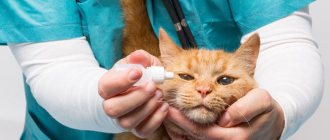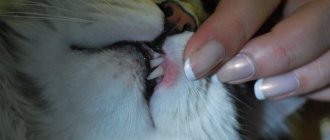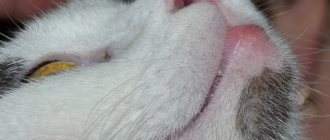Cataracts in cats are a fairly common disease. Our pets, just like us humans, get sick, grow old, and lose their sight. But you can also help them if you notice the symptoms in time and seek help from a veterinarian. The cat will not say that its vision has become worse or that something hurts, but if the owner is attentive to his whiskers, then he will quickly notice the symptoms characteristic of cataracts in cats. So how and with what to treat it? Let's figure it out.
- 3 Causes of appearance 3.1 Predisposition to cataracts depending on breed
Causes of the disease
The main role in the normal functioning of the organ of vision is given to the lens - a transparent biconvex lens that focuses light. The clear lens serves as a conductor for light and images that enter the eye and are analyzed by the brain. Complete or partial clouding of the lens, accompanied by loss of vision, is called a cataract.
Cataracts are the scourge of older animals whose age exceeds 8 years. This is due to the wear and tear of the body's natural resources and slow metabolism.
However, other factors can lead to cataracts:
- trauma to the lens as a result of thermal, chemical burn, foreign body entering the eye, impact, scratches;
- dangerous pathological eye conditions;
- diabetes mellitus, endocrine diseases;
- prolonged exposure to the allergen;
- intoxication of the body (chemical, parasitic).
In addition, cataracts can be caused by viruses and bacteria transmitted by a mother to her offspring during childbirth or in utero.
Cataracts in cats: is prevention possible?
Basic rules for preventing cataracts in cats:
- Avoid injuring your pet.
- Watch what and how you feed your mustache. No alternating or mixing dry and natural food. Do not feed your animal only protein foods. Don’t forget about the ratio of proteins, carbohydrates and fats in your pet’s diet. The water should always be clean.
- Visit your veterinarian at least once a year. Preventive examinations and blood donations will help to detect any pathology in time. Diabetes mellitus in a cat can play a cruel joke. The animal will go blind very quickly, but it is possible to cure a pet, unlike a person suffering from diabetes! The main thing is to start treatment as early as possible and not to make the disease worse.
- Get rid of worms regularly. Vaccinate according to age.
- Don't self-medicate! Any medications are given to the animal only after consultation with a veterinarian, without exceeding the dosage or increasing the course of treatment on your own!
- Be sure to treat your pet if his eyes are sore (conjunctivitis in a cat, keratitis or something else, it doesn’t matter, if you don’t treat the eye now, you can lose it very quickly).
We suggest you read: Nosematosis: treatment and prevention, description of symptoms
If, despite following all the instructions for caring for the animal, a cat still develops cataracts, treatment at home is only possible with regular monitoring by a veterinarian and strict adherence to the prescribed therapy.
When only one lens is covered with a veil, everything is not so scary. And even a situation where a cat has cataracts in both eyes is not fatal. After all, cats, even when completely blind, can navigate in space with the help of tactile sensations, an excellent sense of smell and the finest hearing. Thanks to the care and help of the owner, animals quickly recover from vision loss and adapt to new conditions, living the rest of their lives calmly.
Vision is of paramount importance in the life of a domestic cat, so a decrease in its sharpness or complete loss is an extremely negative event. The cause of blindness is often clouding of the optical instrument of the eye - the lens. Cataracts occur as a result of exposure to various negative factors on the body. Only with timely consultation with a doctor can your vision be saved.
Better than any competent treatment is the absence of disease. A good method in the fight against various ailments is the use of preventive measures. Prevention of cataracts, like other diseases, is aimed at improving the living conditions of the animal and eliminating the causes of the disease. Any recommendations are made by leading veterinarians.
- Below are some requirements that it is advisable to consider when keeping cats:
- nutrition – your pet should fully receive all the necessary vitamins, minerals and trace elements. In order to implement this in practice, you need to adhere to a certain diet, which should be saturated. Both starvation and overeating of the animal should not be allowed;
- Injuries – a cat is a very gentle creature, although they are famous for their dexterity and agility, they can get injured anywhere. If you play with your pet, do not go too far and control the situation. If you are on a walk with him, monitor his behavior and try to prevent fights with other animals;
- visit to the veterinarian – a routine examination by a veterinarian should be an integral part of keeping a pet. A visit to a doctor will prevent the occurrence of many diseases, as well as detect them in the early stages. This will help prevent complications;
- deworm an animal - the influence of parasites has a very bad effect on the functioning of the body as a whole, so it is necessary to deworm the animal as often as the attending physician advises;
- Self-medication is the most common mistake owners make when keeping a pet. Do not treat yourself under any circumstances, as this may cause irreparable damage to the health of the animal;
- other diseases - if there are eye pathologies, they need to be treated in a timely manner to prevent complications from occurring.
If you have any questions about the symptoms and treatment of cataracts in cats, ask them in the comments, we will definitely answer!
Measures to prevent cataracts include avoiding mechanical damage to the organ of vision, regular examinations by an ophthalmologist, and timely treatment of diseases that can cause clouding of the lens.
Interesting topics
- Why does a cat's teeth fall out?
- Vaccination calendar for kittens and cats
- 8 cat breeds with “wrong” ears
- Otodectosis in cats: causes, symptoms
- Types of parasites in cats, effective methods of control
- How to feed an exhausted cat
Reasons for appearance
Pathology occurs when a huge mass of organic (protein, cholesterol, fats) and inorganic (phosphorus, potassium) substances accumulates in the lens against the background of a decrease in fluid mass. Due to these disorders, the cells are transformed; in the lumens formed as a result of their degeneration, a disintegrated mass accumulates on the capsule, which thickens and becomes overgrown with epithelial cells.
Of course, various factors push and trigger the anomalous process. Possible and most common causes of cataracts in cats are as follows:
- Old age. The most common reason. In order for the lens to remain transparent, it needs that the metabolic processes inside it do not stop and are not disrupted. A special ratio of proteins, minerals and water is also required. With age, metabolism slows down, which is why the lens begins to become cloudy.
- Congenital. This happens if the pregnant cat had infectious diseases, parasites, or was treated with drugs without consulting a veterinarian.
- Traumatic. This could be either a blow and bruise or a concussion.
- Metabolic disorders. Because of it, the animal develops so many diseases! This includes obesity, urolithiasis, diabetes mellitus, and endocrine diseases. Cataract is no exception; it also develops as a result of improper metabolism. Therefore, even a young pet may experience changes in the eye if it is fed unbalanced, alternating natural food and industrial food.
- Too long or incorrect use of medications. This is why you should not self-medicate. The chance that you will harm your pet is much higher than that you will cure it yourself.
- Other eye diseases in cats and dogs. They move to the lens, affecting it. For example, a banal increase in intraocular pressure (glaucoma) leads to injury to the lens, as a result of which cataracts develop in cats and dogs.
Predisposition to cataracts depending on breed
Persian and exotic shorthaired beauties suffer the most from lens clouding. Less commonly, the disease is registered in the British and Scottish. But among mestizos (that is, outbred representatives) there are generally isolated cases of cataracts.
In old pets, after 8-9 years, similar changes also begin.
Main symptoms
The initial stage of cataracts is practically asymptomatic. Decreased vision in a cat cannot be noticed due to the fact that the animals’ hearing and sense of smell are excellently developed.
Pathology manifests itself when the optical areas of the lens are damaged. The cat ceases to navigate in an unfamiliar room, moves unsteadily and bumps into furniture and objects, and becomes awkward in games.
A clear sign of cataracts is the appearance of a spot or film on the eye, indicating clouding of the lens.
Symptoms of the disease
Signs of the disease depend on the stage of cataract development. Main symptoms:
- The appearance of a cloudy film or spot on a cat's eyes may be a consequence of the development of pathology. In this case, you should not resort to self-therapy, and you should immediately report the symptoms of cataracts to a specialist.
- If the disease begins to develop due to a genetic predisposition, its first signs can be observed both from the first days of the animal’s life and as it grows up. Therefore, owners of cataract-prone breeds should regularly take their pets for eye examinations.
- If there is cloudiness in the cat's eyes, the cat's vision is weakened. If the owner notices that the pet moves around the house uncertainly, frolics and plays less, you need to consult a doctor and undergo an eye examination.
Feline cataracts, like human ones, develop gradually. To preserve your cat’s vision, therapeutic measures should be taken as soon as possible.
How is cataract treated?
There are other consequences besides blindness, and in most cases they are disastrous. The fact is that when cataracts mature, the changed proteins of the lens gradually extend beyond the boundaries of the lens. Now there is a lot of protein inside the eye, and the immune system of the eye, which has never encountered such a protein before, begins to react to it as if it were foreign.
Thus, inflammation (uveitis) develops inside the eye, directed against the altered lens. After some time (up to three years), cats almost always develop glaucoma (increased pressure inside the eye) due to uveitis. As a rule, such glaucoma is difficult to treat and often causes eye loss.
What is a lens and what is a cataract?
The lens is a large lens located behind the pupil. The main function of the pupil is that it allows you to focus your gaze on an object. To check the operation of the lens, extend your arm forward and focus your gaze on your palm. You will find that you can see your palm clearly, but everything behind it is blurry. Now focus on something behind your palm. You will find that the palm is blurry, but the object behind it is clearly visible. The lens is capable of slightly changing its shape during vision, and this is how refocusing occurs, in simple terms.
The cat's lens consists of a transparent, water-soluble protein, and during the process of cataract maturation, this protein becomes opaque and insoluble in water. Essentially, the structure of the protein changes. As a result, the lens becomes white. Owners may note that the cat's pupils have turned white in one or two eyes, spatial orientation has been disturbed, and the animal has gone blind.
Cataract in a cat
Which breeds are more susceptible
Cataracts can occur in any animal, but there are breeds in which it is most often diagnosed. We are talking about breeds with a brachycephalic skull structure, which provokes the development of destructive processes - exotics, Persians, British, Scots. Cataracts occur in very rare cases in indoor cats.
Types of cataracts
The disease can be unilateral or bilateral. With a unilateral disease, the lens of one eye becomes cloudy. In case of bilateral vision, both organs of vision are affected.
The form of the disease can be congenital or acquired. Congenital cataracts occur as a result of abnormal intrauterine development of the kitten. This can happen if a pregnant cat is infected with parasites or carries infectious diseases.
The acquired disease can be the result of various ophthalmological problems, hormonal imbalances, injuries and other damage to the eye.
Like most diseases, cataracts are divided into primary and secondary. In primary cases, it is a separate, independent disease. In the secondary form, it is considered a consequence of other ailments.
Experts divide the disease into different stages of development: initial, immature, mature, overripe. Depending on the level of neglect, a treatment prognosis is made and individual therapy or surgical intervention is prescribed.
Treatment method and prognosis
Unfortunately, there is no cure for cataracts. The quality of vision will inevitably decline. However, blindness can be prevented with drug therapy. The sooner it starts to behave, the longer the animal will remain sighted.
Treatment is aimed at combating the underlying disease that caused the cataract. So, if clouding of the lens is caused by an infection, antibiotics are prescribed. For diabetes, blood sugar levels are monitored and monitored. Injuries often require surgery.
Conservative therapy using drops of Vicein, Taufon, Vitafacol, Catalin, Quinax is intended to stop degenerative processes in the optical system of the eyes. The effect of these drugs is to activate metabolic processes, improve tissue nutrition, and slow down the deposition of protein structures in the lens.
Treatment is carried out in courses (30 days each, followed by a break of 1 month) under the supervision of an ophthalmologist, as complications are possible. Drops are instilled twice a day, one drop in each eye.
The use of proteolytic enzymes (papain, chymotrypsin), tissue preparations, and immunomodulators can also slow down lens opacification.
A mandatory element of treatment is vitamin therapy to strengthen the immune system. Cats with cataracts should receive vitamins C and B2.
There are also surgical methods for treating cat cataracts - extracapsular resection, intracapsular resection, phacoemulsification. However, you need to understand that they are not carried out in all clinics and are very expensive. In addition, some of them have a high risk of developing the disease again.
Symptoms and treatment
The symptoms of cataracts in cats are difficult to ignore. It's enough just to look into your pet's eyes. When the lens becomes cloudy, instead of a black pupil (which is actually a hole, the diameter of which changes under the action of muscles), a milky spot is visible. Turbidity is noticeable immediately, so regardless of the age of the whisker, examine it yourself and do not forget to visit a veterinarian.
Treatment of cataracts in cats and dogs must be carried out under the supervision of a veterinarian!
No “grandmother’s” methods following “grandfather’s tips” using herbs, bat eye, chicken foot and red dragon saliva. All these miraculous drugs will not help, and their use will only harm the animal. Before giving anything to your pet, ask your veterinarian!
Usually the doctor prescribes special drops in the early stages. But in addition to drops, other drugs are also required, so the veterinarian draws up a comprehensive treatment regimen. He discovers the cause and, if possible, eliminates it and the consequences after it. If there was a metabolic disorder, then change the animal’s diet. If a cat or dog also develops diabetes mellitus, then they get rid of it too. Helminths - away. Hidden inflammatory processes are looked for. In general, a qualified veterinarian will not simply prescribe drops; he will try to eliminate anything that could lead to a relapse.
If the drops do not help or the cat’s cataract has “gone” too far, then surgical intervention will help. Eye microsurgery is not performed in every veterinary clinic. This requires modern equipment. And the doctor must have experience. Therefore, if your pet requires surgery, then, alas, you will have to go to a large city where such surgical intervention is possible.
Unfortunately, drops and vitamins only stop the development of cataracts in a cat, but cannot completely cure it. It is rarely possible to do without surgery.
It is performed under general anesthesia, as various complications may occur. The postoperative recovery period consists of drug therapy and careful monitoring of the pet: you need to exclude bright lighting and make sure that the cat does not hurt its head, scratch its eyes, etc. During surgery, it is possible to remove part of the lens or completely replace it with an artificial duplicate.
Diagnosis of cataracts in cats
To confirm or refute the diagnosis of cataract, in addition to a visual examination of the eyes, the ophthalmologist conducts special examination methods: examination of the organ of vision using side illumination, biomicroscopy.
The retroillumination method helps to identify the exact location of lens opacities. In some cases, retinal electroretinography is prescribed.
Complex diagnostics, as a rule, does not cause difficulties for specialists.
To diagnose cataracts, a comprehensive ophthalmological examination is performed, which includes biomicroscopy, ophthalmoscopy (if possible), ophthalmotonometry, ultrasound of the eye, electroretinography (ERG). If there is a suspicion of diabetic cataract, the cat is prescribed a general clinical examination with blood donation.
Cataract in a cat
When diagnosing cataracts, the following factors are necessary:
- dark room so that there is as little light as possible;
- slit lamp with 10x magnification;
- veterinary ophthalmologist.
Diagnosis of cataracts is carried out to identify the cause of its occurrence and determine treatment methods.
Prevention of cataracts
You can reduce the risk of developing cataracts in your cat by following simple preventive recommendations:
- try to prevent injuries and damage to the organs of vision;
- Treat all diseases promptly and completely;
- visit your veterinarian regularly;
- do not self-medicate;
- Feed your four-legged friend fully and balancedly;
- Vaccinate and deworm your animal in a timely manner.
Cataracts are a disease of the visual organs that can lead to complete blindness. It is important to start treatment promptly, which will be prescribed by a qualified veterinarian. Be patient, surround the animal with care, love, affection, and make up its diet in a complete and balanced manner. Under the strict supervision of a doctor, you can save your cat from an unpleasant illness.
What to do at home
The owner’s task is to provide the most comfortable living conditions for his pet. Like a person, a sick animal needs affection, caring attitude, and attention. A cat losing his sight will feel much more confident if he feels supported by people.
If your pet has undergone surgery, it will be followed by a long rehabilitation period. Recovery includes the use of antibacterial drugs and ophthalmic drops that relieve corneal swelling and pain.
To prevent the cat from scratching its eyes and causing infection, a special collar is put on it. The condition of the operated cat is assessed by a veterinarian: examinations are carried out monthly for six months.
The cat's diet, both during treatment and after surgery, should be balanced in composition and enriched with vitamins.
Stages of development
Cataracts develop in several stages:
- Initial – lasts from 2 – 3 months to one year. It is characterized by:
- slight decrease in visual acuity;
- cloudy edges of the pupils. Note: the first stage can be determined by a veterinarian or an attentive breeder by taking a closer look at the animal.
The last stage cannot be treated. The cat is permanently blind in one or both eyes.
Cataract
The eyes of a cat are a perfect optical device necessary for a solitary predator. Decreased visual acuity significantly worsens the quality of life of a pet. Eye diseases in cats, and cataracts in particular, require immediate treatment. The longer you wait to see a doctor, the lower your chance of avoiding blindness.
Description
Normally, the pupil is completely black. This is the hole through which the iris controls the amount of light entering the eye. The beam then passes through the transparent lens, refracting and focusing on the retina. Here the light is completely absorbed, so the pupil appears black.
The lens is a biconvex lens. It is flexible and mobile - a group of muscles changes the shape of the lens depending on the distance to the object. This is necessary for normal perception of space. Cataracts in cats are an eye disease in which the lens loses its elasticity and transparency.
Light reflects off the cloudy lens, appearing as a whitish or grayish pupil. In fact, the lens is now visible through the hole in the iris. Turbidity occurs due to an irreversible change in proteins - denaturation. The heterogeneous structure of the lens prevents light from penetrating the retina, distorting the image.
This is a progressive eye disease - cataracts in cats, with rare exceptions, lead to blindness. Affects one eye or both, develops in different eyes simultaneously or differently. Pets of all ages, purebred and mongrel, suffer. A tendency has been established among Persians, exotics, Scots, Britons, and mestizos with a shortened skull.
Causes
Lens destruction is considered a multifactorial event. The composition of aqueous humor changes, metabolism decreases, tissue respiration worsens, and toxins accumulate. There are congenital and acquired cataracts - in cats, eye diseases are more often hereditary than age-related.
Congenital form
A kitten is born with a pathology - a consequence of intrauterine toxic damage to the lens. Possible causes: viral infection during pregnancy, calcium deficiency, endocrine disorders, Rh incompatibility.
Cataracts in kittens do not always progress - there are cases of limited clouding without a decrease in visual acuity. The pet is observed for life, without taking action until the development of congenital eye disease is confirmed. But cat cataracts are operated on from an early age, so degenerative changes can be stopped at any time, preventing the situation from worsening.
Acquired form
There are many causes of cataracts in cats. Sometimes this eye disease is diagnosed as idiopathic - the doctor does not find the factor that influenced the changes in the structure of the lens. Types of acquired cataracts:
- Hereditary can be congenital, but more often the lens begins to become cloudy in the period from 2 to 6 years. Confirmed by genetic tests.
- Age-related cataracts develop after 8 years of age. It usually progresses slowly, which allows time to prepare for surgery.
- Traumatic – a response to damage to the lens and/or cornea. Contusions, penetrating wounds, thermal effects.
- Complicated – a consequence of another eye disease: cataracts in cats due to glaucoma, retinal detachment, uveitis, iris dysfunction.
- Toxic occurs due to long-term use of corticosteroids, drugs for epilepsy, poisoning with thallium, naphthalene, and overdose of certain drugs.
- Diabetic is a consequence of an increase in glucose levels in the lens. These cataracts are usually mild and quickly progress to blindness.
Cloudiness can develop due to an allergy to food, litter, parasites, or household chemicals. Even when the allergy is expressed only by dandruff, slight lacrimation or unobtrusive itching, substances toxic to cells accumulate in the lens.
Symptoms
Progressive cataracts in cats are an eye disease that is almost impossible to notice in the initial stages. The cat is helped by its excellent hearing and sense of smell. With the help of her whiskers, she navigates a familiar room by touch. Coordination problems appear as the disease progresses:
- Initial cataract. Vision is preserved, although the cat already sees worse, as if through a veil. The owner, even taking a special look, is unlikely to notice the beginning of clouding of the pupil;
- Immature cataract. An attentive observer will note the cat’s awkwardness in the game when he jumps to a height and tries to catch a toy. The pupil is clearly cloudy. With ophthalmoscopy, the fundus of the eye is already poorly visible;
- Mature cataract. Severe blurring, almost complete loss of vision. The cat barely sees the light, cannot distinguish objects, and constantly bumps into walls and furniture.
- The last stage is mature cataract. For a cat, this means complete blindness, and the chance of restoring vision drops sharply. The lens is destroyed - now it is a bag of viscous liquid with a core lying at the bottom.
One sign may be a change in behavior. Losing their vision, many pets become insecure and inactive. Anxiety increases - the cat is timid or even aggressive, especially with strangers. Having stopped relying on her eyes, she moves more slowly, stretching her head forward, feeling her way with her whiskers, and sniffing often.
Diagnostics
The lens is conventionally divided into two parts by the equator line. The anterior part of the capsule is lined with epithelial cells. In cross section it resembles an onion - as the epithelium grows, the layers of fibers become denser towards the center, forming a core. Between it and the wall of the capsule is the cortex.
Before choosing a behavioral tactic, it is important to establish the localization of the cataract. You can’t ask the cat what she sees, and during a routine examination, the veterinarian will only determine the presence of clouding, but not its type. Therefore, you need to contact ophthalmologists at a clinic equipped with the equipment necessary for a deep examination of the eye.
| Type | Location |
| Polar | Anterior polar - a spot under the capsule at the anterior pole, posterior polar - at the posterior. Two spots – anteroposterior polar cataract. |
| Fusiform | A chain of punctate opacities, shaped like a spindle. Passes through the center of the lens from the anterior to the posterior pole. |
| Layered | In one or more layers around the core. Turbid layers alternate with transparent ones. |
| Layered peripheral | Cloudiness of the layers at the periphery, does not merge into rings around the core. |
| Cup-shaped or posterior subcapsular | Cloudiness and thickening of the back layer of the lens. |
| Nuclear | It appears in the core, slowly filling it completely. As a rule, vision decreases over the years, gradually. |
| Cortical | Changes in the anterior and posterior cortical layers are uneven, often sluggish in both eyes. |
Total cataracts in cats are a disease of both eyes in which the lens material turns into a cloudy mass. Progresses rapidly to blindness and requires immediate intervention. In any case, it is advisable to conduct a full range of studies using a slit lamp, measuring intraocular pressure, and examining the fundus.
In the later stages of cataracts, it is not possible to assess the condition of the fundus using an ophthalmoscope. Ultrasound is indicated to exclude destruction of the vitreous body, retinal detachment and other concomitant eye diseases.
Treatment
Surgical only. No drops, ointments, irradiations or other “innovative” methods can reverse the disease or stop the destructive processes. Evidence-based medicine completely excludes the beneficial effects of any conservative methods of treating cataracts in cats and other animals.
First aid
In the initial stages, the cat does not experience physical pain. No need to put drops in your eyes or put ointment under your eyelids. If vision has deteriorated significantly, movement is limited to one room. The tray, bowls, and bed should be freely accessible, and if possible, obstacles to them should be removed.
Without treatment, cataracts in cats lead to serious complications: swelling, development of secondary glaucoma, malignant panophthalmitis, uveitis. An increase in intraocular pressure leads to the death of the optic nerve. It is important to contact a veterinarian as soon as possible - the disease progresses every day.
Basic treatment
In cats, cataracts are operated on only under anesthesia, with preliminary examination and, when time permits, preparation for general anesthesia. In most cases, phacoemulsification is performed followed by implantation of an artificial lens. This is a relatively simple operation for an ophthalmologist, lasting up to half an hour.
Using a special “vacuum cleaner”, the doctor destroys the contents of the capsule, sucks out the remains and places a new transparent lens in its place. It expands inside, filling the free space. Vision begins to recover immediately after surgery, and the patient can go home the next day.
SEE ALSO: Cataract in the picture Cataract g Medicine cause of cataract Removal of cataract eyes regimen after surgery










